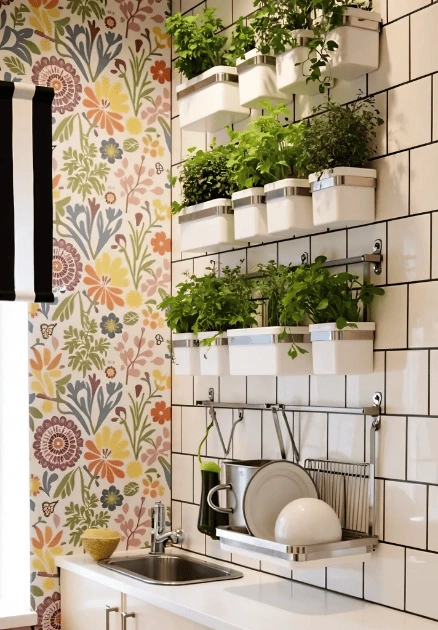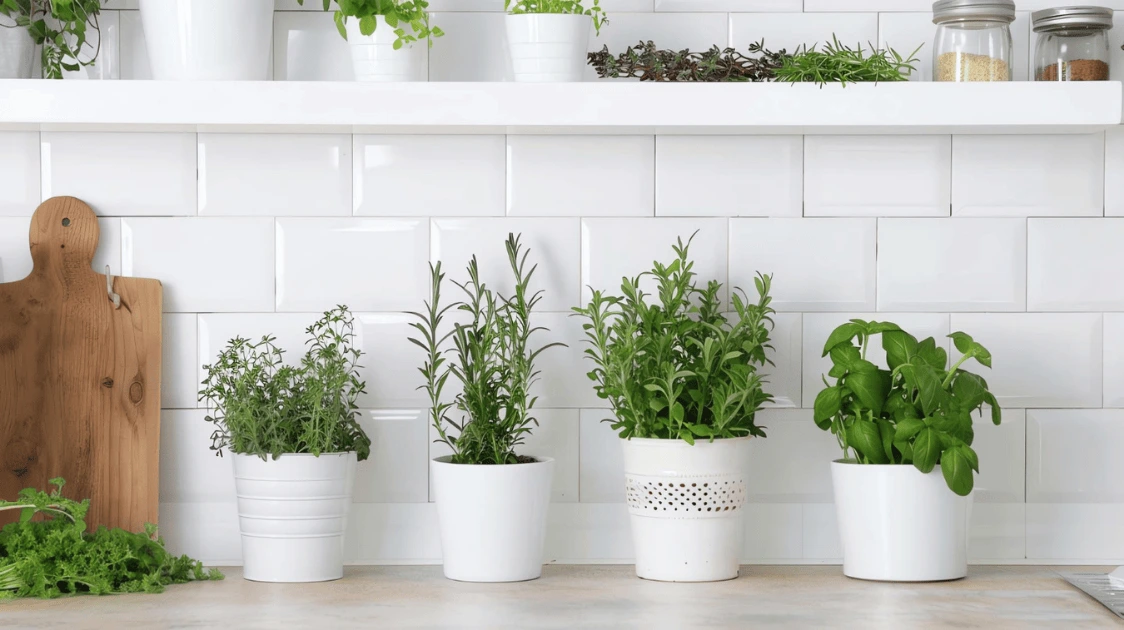Why Create a Vertical Kitchen Garden? 🌿
Transforming your kitchen into a lush, functional space has never been easier. A vertical kitchen garden brings multiple benefits to your home, including:
- Convenience: Fresh herbs within arm’s reach while cooking.
- Sustainability: Grow your own ingredients and reduce waste.
- Aesthetic Appeal: Enhance your kitchen with vibrant greenery.
- Improved Air Quality: Plants naturally purify the air, creating a healthier environment.
By creating a vertical kitchen garden, you combine style, sustainability, and practicality in a way that fits perfectly into modern urban living.
Watch and Learn: Create Your Vertical Kitchen Garden! 🎥
Before you start building your vertical garden, check out this video that guides you through the process of setting up your own vertical garden using the Greenstalk Planter System. It’s easy, practical, and will inspire you to grow your own herbs and vegetables, even in small spaces!
👉 Watch Now: How to Create a Vertical Kitchen Garden Using the Greenstalk Planter System
Ready to Start? Let’s Dive In! 🛠️
Now that you know why creating a vertical kitchen garden is a great idea, let’s get started on how to build one in your own home!
How to Create Your Vertical Kitchen Garden 🪴
Step 1: Choose the Perfect Spot 📍

Look for a well-lit area near your cooking space. Your plants will need at least 4–6 hours of natural light daily, so ensure the spot you choose receives plenty of sunlight. If natural light is insufficient, you can install grow lights to supplement the light.
Pro Tip: Avoid placing plants near heat sources like stoves, ovens, or radiators to protect delicate leaves. If space is tight, consider a corner wall or the back of a pantry door for vertical installations.
Step 2: Select the Right Herbs 🌱
When choosing herbs for your vertical kitchen garden, it’s important to pick those that thrive indoors and complement your cooking. Here are some great options:
- Basil 🍃: Ideal for Italian dishes and fresh pesto.
- Mint 🌿: Perfect for teas, desserts, and savory dishes.
- Parsley 🌱: A garnish that adds freshness to any meal.
- Cilantro 🌿: Essential for Mexican and Asian cuisine.
- Thyme 🍂: Great for soups, stews, and roasted dishes.
- Chives ✂️: A mild onion flavor for salads and dips.
🌟 Pro Tip: Rotate seasonal herbs like dill or oregano to keep your garden fresh and exciting!
Step 3: Choose a Vertical Structure 🛠️
Your vertical kitchen garden can be as simple or creative as you like. Some ideas include:
- Rustic Wooden Frames: Add a cozy, natural vibe to your kitchen.
- Magnetic Pots: Perfect for small spaces and easy to rearrange.
- Hanging Planters: Create a layered look for more variety.
- Repurposed Items: Old ladders, pallets, or recycled jars make sustainable options.
- Wall-Mounted Shelves: Functional and modern, ideal for maximizing space.
🌟 Bonus Tip: Use chalkboard paint on planters to label each herb practical and decorative!
When choosing the structure for your vertical garden, you can opt for something simple, like shelves or wall hooks 📚🔨, or get more creative with recyclable containers ♻️ and reused materials.
One great idea is to use reclaimed pallets 🌿, which are eco-friendly, affordable, and durable. For more tips on how to effectively use pallets, check out our comprehensive guide on How to Create Vertical Gardens with Reused Pallets Sustainably 🌱.
Step 4: Prepare Your Pots 🪴
To ensure healthy growth, it’s important to choose the right materials for your pots:
- Select containers with drainage holes to avoid water buildup at the base.
- Add a layer of pebbles before soil for optimal drainage.
- Choose lightweight, breathable materials like terracotta or eco-friendly recycled plastics.
🌱 Recommended Soil: A high-quality potting mix with added compost or organic matter works best for herbs.
Step 5: Planting Your Herbs 🌱
Fill your pots with nutrient-rich potting soil. Then, plant seeds or seedlings at the recommended depth and water gently. Arrange the pots in your chosen structure and ensure they are spaced evenly to allow proper airflow and prevent mold growth.
Step 6: Watering and Lighting 💧☀️
Watering: Keep the soil moist but not soggy. Water the plants when the top of the soil is no longer moist.
Lighting: Ensure your herbs receive 10–12 hours of light daily. If you don’t have enough natural light, use energy-efficient LED grow lights to mimic sunlight and save electricity.
Creative Design Ideas for Your Kitchen Herb Garden 🎨

Your vertical kitchen garden should be both functional and visually appealing. Here are some fun ideas:
- Rustic Wooden Frames: Use chalk labels for a farmhouse touch.
- Magnetic Pots: Stick them on your fridge for easy access.
- Colorful Planters: Match your kitchen decor with vibrant pots.
- Living Wall Art: Arrange herbs in geometric patterns for a modern look.
- Hanging Mason Jars: Combine sustainability with style.
🌟 Design Hack: Mix herbs with trailing plants like ivy for a lush, layered effect.
Maintenance Tips for a Thriving Herb Garden 🧹
To keep your vertical kitchen garden flourishing, follow these tips:
- Prune Regularly: Prevent overcrowding and encourage new growth.
- Pest Control: Use natural solutions like neem oil or insecticidal soap.
- Rotate Plants: Ensure even light distribution by occasionally repositioning pots.
- Fertilize Sparingly: Use organic options every few weeks to replenish nutrients.
- Avoid Overwatering: Too much water can lead to root rot check soil before watering.
🌟 Expert Advice: Wipe plant leaves occasionally to remove dust and improve light absorption.
Common Challenges and Solutions 🛠️
Challenge 1: Herbs Wilting Quickly
Solution: Check for overwatering or insufficient drainage. Adjust light exposure as needed.
Challenge 2: Slow Growth
Solution: Use a liquid organic fertilizer and ensure adequate light.
Challenge 3: Pests on Leaves
Solution: Spray with a mixture of water and mild dish soap or neem oil.
FAQs About Kitchen Herb Gardens ❓
- Q: How much light do herbs need?
A: Most herbs do well with 4 to 6 hours of light each day. Supplement with grow lights if necessary. - Q: Can I grow herbs in a kitchen with no windows?
A: Yes! Invest in LED grow lights to mimic natural sunlight. - Q: How often should I water my herbs?
A: Check soil moisture every few days. Water the plants when the top layer of soil is dry. - Q: What’s the best way to harvest herbs?
A: Trim the leaves from the top to promote new growth and enjoy your fresh herbs right away!✂️ - Q: Is it possible to grow several herbs in a single pot?
A: Yes, but make sure they have similar light and water requirements. Overcrowding can affect growth.
Conclusion: Start Your Vertical Kitchen Garden Today! 🌟
With a vertical kitchen garden, you’ll enjoy fresh flavors, better air quality, and a beautiful kitchen every day. Creating one is an excellent way to bring the joy of gardening indoors, no matter how small your space is.
For more inspiration on creating efficient and space-saving herb gardens, check out this article: Clever Vertical Herb Gardens
Happy planting! 🌿

